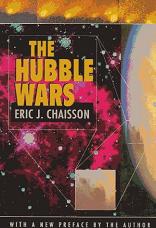
The Hubble Wars
Eric J. Chaisson
386 pages including index
published in 1994/1998
Having worked on a somewhat troubled project for the past few years, it's a great comfort to know that even big science projects like the Hubble Space Telescope can suffer from similar problems. In Hubble's case, bad project management and quality control meant it was only discovered after the space telescope had been launched that its main mirror had a serious flaw in its grinding which meant that it couldn't focus properly. But that was only the most *ahem* visible of the Hubble project's problems, as Eric J. Chaisson explains. And he should know, as he was a senior staff scientist at the Space Telescope Science Institute when these problems occurred and hence had a first rank seat for them.
The Hubble Wars was originally published in 1994 and based on notes Chaisson made during Hubble's commisioning period after launch, when the problems with the lens, as well as several others first cropped up. This then was largely written in the heat of the moment, without the benefit of hindsight, even if the edition I got out of the library was the updated 1998 one. This update was largely confined to a new foreword, an attempt to correct some of the misconceptions and hyberbole in the news coverage of Hubble discoveries. The rest of the book was largely left unchanged, though every now and then new developments are alluded to -- and they're not always well integrated. But that's just a minor quibble. What remains is an important insight in how a big science project can go wrong, as it happened.
Much of The Hubble Wars revolves around the internal conflicts within the project during Hubble's commisioning period after the launch, which can be caricatured as conflicts between the engineers (NASA, the contractors who build the telescope) and the scientists (the Space Telescope Science Institute, various contributing astronomers etcetera). The first were more interested in getting the spacecraft under control and getting it to behave, with little or no interest in using it for what it was intended to, astronomy. Meanwhile amongst the scientists opinions were divided. Chaisson and his co-workers at the institute were trying to determine what was still possible to do with the handicapped space telescope, trying to at least get some good pictures out of it to counter the flood of bad publicity about Hubble. Others however were adamant in their refusal to allow anybody else access to "their" objects, no matter how beneficial it would be for the image of the project as a whole. In this whole mess you'd expect NASA to take charge, but the topheavy bureaucracy was more interested in covering its own asses, scared to make any decision it case it would lead to more bad publicity.
And this is the biggest revelation in this book, the weakness of NASA's leadership and its ossified internal structures, which meant that it just couldn't respond quickly, nor act decisively. Chaisson shows time and again how desperate NASA is to keep up its public can do reputation by promising the moon, but is incapable of even delivering simple projects on time, with opportunities lost through its slow and cumbersome decision making processes, until in the end the Space Telescope Science Institute started to work around it.
What also surprised me is how Chaisson portrays his own profession, astronomers. In return for their support during the design and building of Hubble, various astronomers had gotten guaranteed observation time on it after launch and exclusivity on their own projects. Once everything started to go wrong, you'd expect these people to be eager to help the project restore its image and work through its problems. Instead quite a few of them were only interested in keeping what they were "owned". There are several wince inducing scenes were quite senior astronomers --though no names are named-- throw hissy fits.
The Hubble Wars is as illuminating about the technical problems plaguing the space telescope as he is about the human problems. He explains quite well what exactly was wrong with the telescope's main mirror, how it was grinded to almost, but not quite the right angle and how this little flaw meant that instead of focusing the infalling light perfectly, it was scattered around an obseved object, which in turn meant it was much less useful in observing faint objects than had been hoped, though Chaisson argues that it was still capable of doing a lot of useful research not possible with a ground based telescope. The explenations he gives of this and other problems with the telescope take some effort to understand, but than these were no simple problems.
This was an interesting book to read, for the insight it gives in how big science operates and the quite recognisable problems a project like the Hubble Space Telescope has to deal with. Whets my appetite for more.